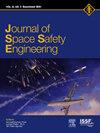共振衰减地球同步转移轨道上立方体卫星共用弃星轨道寿命的概率评估
IF 1.7
Q3 ENGINEERING, AEROSPACE
引用次数: 0
摘要
近年来,地球同步轨道上的立方体卫星飞行任务越来越多。这些飞行任务的典型做法是将立方体卫星部署在地球同步转移轨道(GTO)上,这样的近地点高度足够低,大气阻力会导致远地点高度衰减并最终重返大气层。然而,对于地球同步转移轨道来说,要证明符合轨道碎片缓减准则中对轨道寿命的限制并不简单,这是因为太阳共振现象的存在会导致卫星轨道寿命的高度可变性。本文介绍了一种程序,用于确定共振地球同步转移轨道上的共享立方体卫星的轨道寿命低于25年和5年限制的可能性。该程序采用蒙特卡洛分析法,随机改变不确定参数,包括发射时间/初始 RAAN 和阻力系数。航空航天精确传播工具 TRACE 与高保真力模型一起使用,以实现近地点大气层的精确整合。研究表明,保持低于 25 年和 5 年轨道寿命限制的可能性存在系统性差异,可能需要阻力增强装置来满足立方体卫星共乘的 5 年限制。该研究还介绍了太阳辐射压力诱导共振的发现,该共振是在高面积质量比的情况下观察到的,表明在增加阻力增强装置的面积以加速脱轨时,回报可能会递减。本文章由计算机程序翻译,如有差异,请以英文原文为准。
Probabilistic assessment of disposal orbit lifetime for CubeSat rideshares on resonant decaying geosynchronous transfer orbits
Recent years have seen an increase in CubeSat missions on rideshares to geosynchronous orbit. The typical practice for these missions is to deploy the CubeSat on a geosynchronous transfer orbit (GTO) which results in a perigee altitude that is low enough that atmospheric drag will cause the apogee altitude to decay and eventual reentry. However, for GTOs, demonstrating compliance with limits on orbital lifetime in orbital debris mitigation guidelines is not straightforward due to a solar resonance phenomenon that exists which can cause high variability of the orbital lifetime of the satellite. This paper presents a procedure for determining the likelihood that orbital lifetime of a rideshare CubeSat on a resonant GTO will have an orbital lifetime below a 25-year and 5-year limit. The procedure uses a Monte Carlo analysis in which uncertain parameters are randomly varied, including the launch time/initial RAAN and the drag coefficient. The Aerospace precision propagation tool TRACE is used with a high-fidelity force model to enable precision integration through the atmosphere at perigee. It is shown in the study that there is a systematic variation in likelihood of staying below a 25- and 5-year orbital lifetime limit and that drag enhancement devices may be needed to meet the 5-year limit for CubeSat rideshares. The study also presents findings on a solar radiation pressure induced resonance that was observed for high area-to-mass ratios which suggests that there can be a diminishing return when increasing the area of a drag enhancement device to quicken deorbit.
求助全文
通过发布文献求助,成功后即可免费获取论文全文。
去求助
来源期刊

Journal of Space Safety Engineering
Engineering-Safety, Risk, Reliability and Quality
CiteScore
2.50
自引率
0.00%
发文量
80
 求助内容:
求助内容: 应助结果提醒方式:
应助结果提醒方式:


